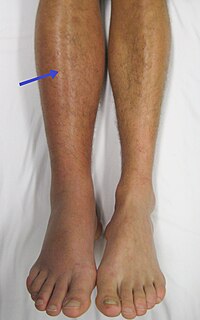
Photo from wikipedia
Objective: Atrial fibrillation (AF) and venous thromboembolism (VTE) share several risk factors related to arterial thromboembolism. No study has reported the differential contribution to arterial thromboembolic events and mortality between… Click to show full abstract
Objective: Atrial fibrillation (AF) and venous thromboembolism (VTE) share several risk factors related to arterial thromboembolism. No study has reported the differential contribution to arterial thromboembolic events and mortality between these two conditions in the same population. We therefore assessed the differential arterial thromboembolic events between AF and VTE. Methods: We included AF and VTE national cohorts derived from Taiwan National Health Insurance Research Database between 2001 and 2013. The eligible population was 314,861 patients in the AF cohort and 41,102 patients in the VTE cohort. The primary outcome was arterial thromboembolic events, including ischemic stroke, extracranial arterial thromboembolism (ECATE) and myocardial infarction (MI). Secondary outcomes were all-cause mortality and cardiovascular death. Results: After a 1:1 propensity matching, 32,688 patients in either group were analyzed. The risk of arterial thromboembolic events was lower in the VTE cohort than that in the AF cohort (subdistribution hazard ratio [SHR], 0.60; 95% confidence interval [CI], 0.57–0.62). The risk of ischemic stroke (SHR, 0.44; 95% CI, 0.42–0.46) and MI (SHR, 0.80; 95% CI, 0.72–0.89) were lower in the VTE cohort, while the risk of ECATE (SHR, 1.23; 95% CI, 1.14–1.33; particularly lower extremities) was higher in the VTE cohort. All-cause mortality rate was higher in the VTE cohort (HR, 1.18; 95% CI, 1.15–1.21) while the risk of cardiovascular death was lower in the VTE cohort (HR, 0.96; 95% CI, 0.93–0.995). Conclusions: Patients with AF had higher risks of arterial thromboembolic events compared to patients with VTE, despite having risk factors in common. The VTE cohort had higher risks of all-cause mortality and ECATE, particularly lower extremity events, compared to AF patients. The differential manifestations of thromboembolism sequelae and mortality between AF and VTE patients merit further investigation.
Journal Title: Frontiers in Cardiovascular Medicine
Year Published: 2021
Link to full text (if available)
Share on Social Media: Sign Up to like & get
recommendations!